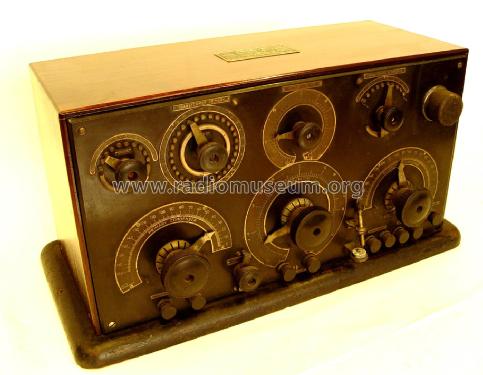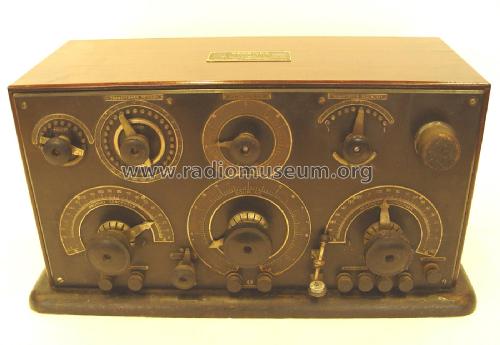106 Receiver 2nd version 8 Binding Posts
Marconi Wireless Telegraph Co. of America
- Produttore / Marca
- Marconi Wireless Telegraph Co. of America
- Anno
- 1915/1916
- Categoria
- Radio a galena (a cristallo o a diodo, senza valvole o transistores)
- Radiomuseum.org ID
- 362337
-
- alternative name: American Marconi || Marconi, American
- Brand: Marconiphone
- Principio generale
- Rivelazione a galena / semi-conducteur
- Gamme d'onda
- Onde medie (OM) e onde lunghe (OL).
- Tensioni di funzionamento
- Batterie a secco
- Altoparlante
- - Per cuffie o amplificatori esterni
- Materiali
- Mobile in legno
- Radiomuseum.org
- Modello: 106 Receiver [2nd version 8 Binding Posts] - Marconi Wireless Telegraph Co.
- Forma
- Soprammobile a cassapanca o cassetta, solitamente con coperchio (NON a leggio)
- Dimensioni (LxAxP)
- 23 x 12 x 11 inch / 584 x 305 x 279 mm
- Annotazioni
-
Production of the Marconi 106 continued at the Marconi Aldene plant in New Jersey until late 1919 when Marconi was absorbed into RCA. The 106 was equipped with two types of crystal detectors. A cerusite crystal and a carborundum. The cerusite was somewhat more sensitive but the carborundum was more stable in shipboard applications. The appropriate detector material for existing conditions was then placed in the single detector crystal holder mounted on the front panel of the receiver.
The first design changes to the 106 came in mid-1915. These changes included replacing the buzzer with a two screw cover buzzer with a new buzzer with a twist off cover and adding a fourth binding post to the right side of the detector. This added binding post allowed the operator to reverse bias the carborundum detector without disturbing the buzzer circuit. The twist cover on the buzzer allowed the operator to easily remove the buzzer cover for buzzer adjustments.
The 2nd version still had all 8 binding post along the lower bottom of the front panel. Two pairs were located to the left of the detector and three more located to the right. The first four pairs were assigned 1-4 but the bottom of the detector was assigned number 5. The four posts to the right of the detector were then assigned 6 ,7, 8 and 9.
All 106 receivers covered the 200-3500 meter wave lengths and were used primarily for marine applications.
- Peso netto
- 32 lb (32 lb 0 oz) / 14.528 kg
- Bibliografia
- Radiola, the golden Age of RCA (Vacuum Tubes in Wireless Communication, Elmer E. Bucher, 1918, p.15)
- Letteratura / Schemi (1)
- June, 1917 Electrical Experimenter magazine page 112
- Autore
- Modello inviato da Alan Larsen. Utilizzare "Proponi modifica" per inviare ulteriori dati.
- Altri modelli
-
In questo link sono elencati 33 modelli, di cui 33 con immagini e 3 con schemi.
Elenco delle radio e altri apparecchi della Marconi Wireless Telegraph Co. of America
Collezioni
Il modello 106 Receiver fa parte delle collezioni dei seguenti membri.



